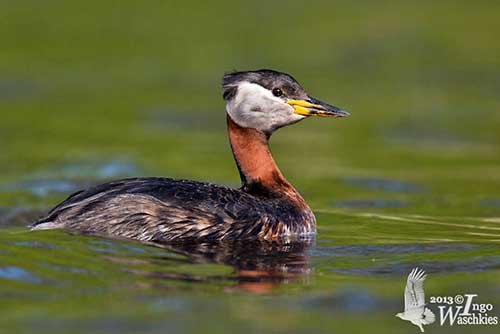
Fr: Grèbe jougris
Ang: Red-necked Grebe
All: Rothalstaucher
Esp: Somormujo Cuellirrojo
Ita: Svasso collorosso
Nd: Roodhalsfuut
Sd: Gråhakedopping
Photographers:
John Anderson
John Anderson Photo Galleries
Tom Grey
Tom Grey's Bird Pictures et Tom Grey's Bird Pictures 2
Otto Plantema
Trips around the world
Ingo Waschkies
My bird pictures on Pbase
Text by Nicole Bouglouan
Sources:
HANDBOOK OF THE BIRDS OF THE WORLD vol 1 by Josep del Hoyo-Andrew Elliot-Jordi Sargatal - Lynx Edicions - ISBN: 8487334105
THE COMPLETE BOOK OF BRITISH BIRDS – Written by “Royal Society for the Protection of Birds” experts - Préface de Magnus Magnusson - Michael Cady- Rob Hume Editors - ISBN: 0749509112
THE HANDBOOK OF BIRD IDENTIFICATION FOR EUROPE AND THE WESTERN PALEARCTIC by Mark Beaman, Steve Madge - C. Helm - ISBN: 0713639601
ENCYCLOPEDIE DES OISEAUX DE FRANCE ET D’EUROPE – de Peter Hayman et Rob Hume - Flammarion – ISBN : 2082009920
Animal Diversity Web (University of Michigan Museum of Zoology)
All About Birds (Cornell Lab of Ornithology)
Bird Web (Seattle Audubon Society)
What Bird-The ultimate Bird Guide (Mitchell Waite)
Red-necked Grebe
Podiceps grisegena
Podicipediformes Order – Podicipedidae Family
INTRODUCTION:
The Red-necked Grebe is a colourful, noisy bird during the breeding season, performing complex courtship displays while calling loudly. However, during winter, it becomes silent and solitary, showing a dull greyer plumage.
Two subspecies share the wide range in the northern hemisphere, breeding in the northernmost regions and wintering in the southern part.
The Red-necked Grebe is a strong swimmer and diver, able to remain underwater when searching for preys. It rarely flies except for migrating at night over land, and along the coastlines by day.
The species is not globally threatened, except by the usual pollutions, degradation of wetland habitat, human disturbance and natural predation.

DESCRIPTION OF THE BIRD:
Biometrics:
Length: 40-50 cm
Weight race grisegena: 550-1000 g
Weight race holbollii: 640-1616 g
The Red-necked Grebe adult male in breeding plumage has brownish-black upperparts with dark wings showing two conspicuous white patches. The larger patch is on the secondaries and the smaller area on the lesser coverts, at base of the leading edge.
On the underparts, foreneck and upper breast are deep chestnut, the belly is paler, mostly white, body sides and flanks are grey-brown with some chestnut/white markings. The underwing is paler with pale grey to whitish coverts.
The head is black to the lower edge of the eye and the lores. On the nape, the feathers are longer and form a slight, lateral, erectile mane. The central hindneck is very dark brown, fading into the brownish-grey upperparts.
There is a distinctive pale grey cheek patch with white margins, extending upwards to behind eye and ear-coverts.
The robust bill is black with variable amount of bright yellow at base. The eyes are dark brown. Legs and feet are dark grey.
Male and female are similar, with the male slightly larger than the female.
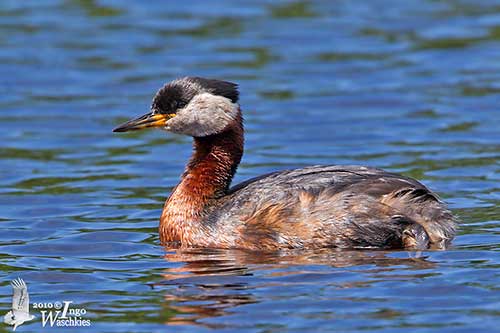
The Red-necked Grebe adult in non-breeding plumage is less blackish, mostly dark grey on the upperparts. Cheeks and ear-coverts are tinged brownish-grey, involving only a slight contrast with the black crown. Chin, throat and breast are whitish. Sides of nape are pale. Most of neck is grey to brownish, but the foreneck is paler. Body sides and flanks are greyer, more whitish on the upper flank. The yellow base of the bill is duller.
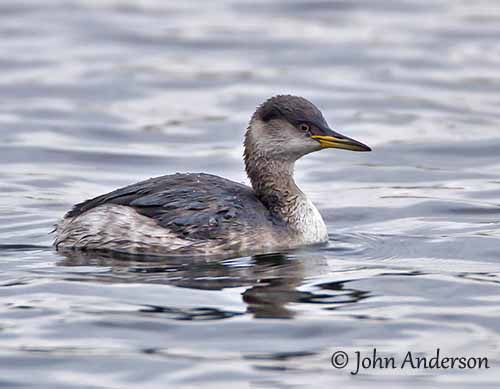
P.g. grisegena
Immature ( yellow eyes)
The juvenile resembles non-breeding adult, but it has brownish-red neck and two conspicuous black bands on head sides.
The immature has greyer plumage than the non-breeding adult, and some brownish tinge on the foreneck. It has yellow eyes.
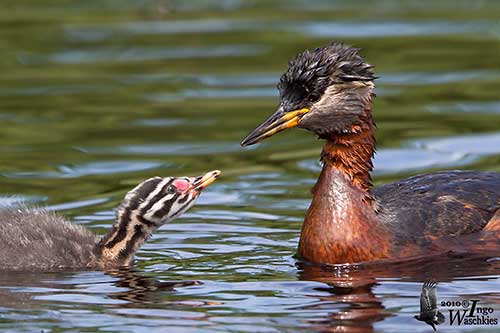
P.g. grisegena
Chick and adult
SUBSPECIES AND RANGE:
The Red-necked Grebe has two subspecies.
P.g. grisegena (described above) breeds in E Europe and W and WC Asia. It winters from North Sea, E to Caspian and Aral Seas.
P.g. holbollii breeds in E Russia S to Manchuria and N Japan, and E to W and C Canada and NW USA. It winters from E China, Korea and Japan, through Aleutian Islands to W Canada and W USA, S to California, and also E Canada and E USA, S to Florida.
This race is larger with longer bill than nominate. It has greyer and paler upperparts and more extensive yellow at base of the bill. The first winter has darker grey face.
HABITAT:
The Red-necked Grebe breeds on small inland freshwater lakes, shallow marshy areas with much emergent vegetation, sometimes on very slow-moving rivers and pools cut off from sea.
The nominate race prefers smaller and shallower waterbodies with surrounding vegetation or forest, and shrub tundra on N of range.
Outside breeding season, and especially during migration, the stopovers usually include rivers, large lakes and ocean coastlines that occur along their route.
During winter, the Red-necked Grebe (both subspecies) can be found in coastal waters and large inland seas and lakes. They winter in bays, inlets or estuaries, and may venture away from land on the open ocean.
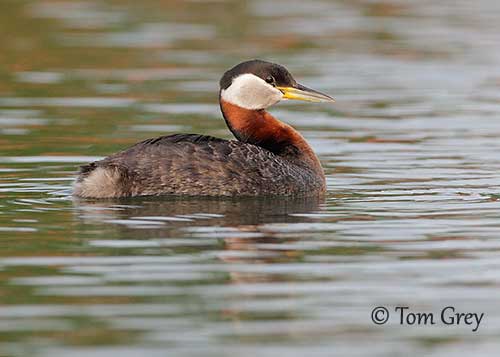
CALLS AND SONGS: SOUNDS BY XENO-CANTO
The Red-necked Grebe is very vocal on the breeding grounds, and has wide repertoire including loud, repeated, wailing howl “uoooh, uoooh, uoooh” often ending in a harsh braying “whaa-whaa-whaa-chiterrrrrrr” reminiscent of Water Rail.
This call is given in territory defence. The alarm call is a harsh “cherk” sometimes repeated at varying intervals.
The Red-necked Grebe usually calls from cover and the pairs often duet.
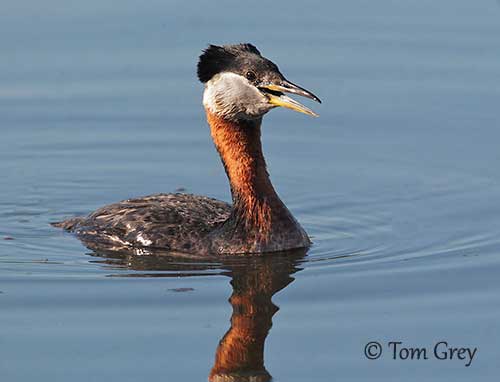
BEHAVIOUR IN THE WILD:
The Red-necked Grebe feeds mainly on insects during the breeding season, and forages on marshes and ponds. But crustaceans, molluscs, tadpoles, worms and some plant matter are part of its diet.
During the winter in coastal waters, it feeds primarily on small fish.
In America, the race holbollii takes more fish, about 55% of the diet, and between 22 and 92% during the breeding season, according to prey availability. It also feeds on insects, crustaceans and leeches when fish is absent.
The Red-necked Grebe is usually very active and stays on water surface only for short period. It forages while swimming underwater, or on the surface with the head submerged, mainly in shallow water. It dives and pursues the prey underwater, or takes it from the bottom or off vegetation. Insects are caught from the water surface and from the emergent vegetation, and some low-flying insects are caught from the air.
The prey is usually swallowed underwater, but a larger prey is brought back to the surface. It is swallowed head first once killed by punching or shaking it in the bill.
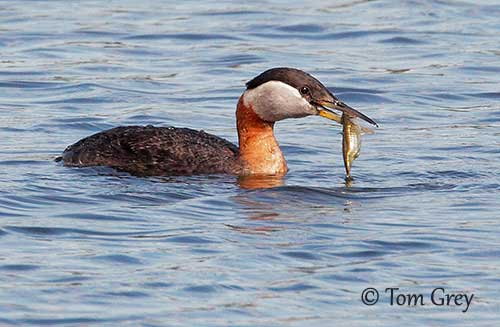
Like other grebes, the Red-necked Grebe ingests large amount of its own feathers which remain in the stomach, probably as protection from indigestible food items.
The parents give feathers to the young birds too, soon after hatching, and even before feeding then for the first time. The feathers accumulate and decompose in the main compartment of the stomach, and this material is mixed with the food, mainly fish, and forms a feather-ball. It is regurgitated in the form of pellets with the indigestible parts of the preys. The fish-eating species take larger amount of feathers than other grebes.
The Red-necked Grebe becomes territorial during the breeding season. The territory is strongly defended against congeners, and the bird threatens or attacks by diving underwater to chase away the intruders.
They become very vocal and call loudly during the defence of the territory and the courtship displays. The pairs form on the wintering grounds and return to the breeding grounds in April.
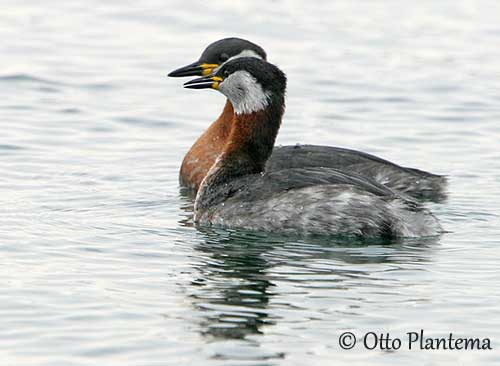
The displays are complex, with the birds calling and raising their crest. Both mates face each other while raising their bodies partly out of water, breasts to breast, and making loud ticking sounds. They also dive to the bottom and pull out vegetation with the bill, and presenting it to each other. The copulation usually takes places on the nest-site.
The “dancing” duets between potential mates are an important part of the courtship displays, with parallel rushes in upright stance over water.
They are seasonally monogamous. They may breed as solitary pairs or colonially. They usually produce a single brood per year, but replacement clutch occurs if nest, eggs or chicks are destroyed.
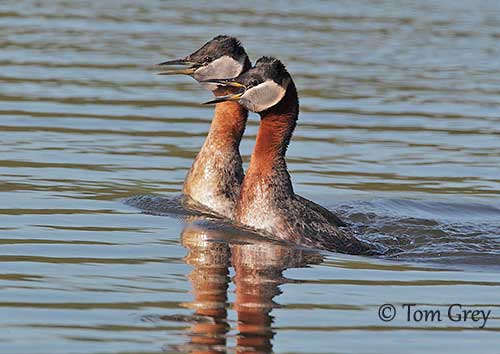
The Red-necked Grebe is migratory and travels at night over land and during the day along the coasts. It migrates alone or in small groups. They also perform dispersive movements to the coasts after breeding. They usually winter at sea, often in bays and estuaries, and also well offshore near shallow banks and islands.
The Red-necked Grebe has direct flight with rapid wingbeats. The white wing patches are well visible in flight.
REPRODUCTION OF THIS SPECIES:
The breeding season occurs between April/May and August/September, usually later towards North. The Red-necked Grebe often breeds solitary, but sometimes in loose colonies.
The nest is built by both mates. It is a floating platform made with aquatic plants, and often anchored to the vegetation, in shallow water along marshy vegetation.
The female lays 3-4 whitish eggs and both adults incubate during 21-24 days (race grisegena), and longer, up to 29 days in North America (race holbollii). The downy chicks have brownish-grey down with some indistinct markings, whereas head and neck are conspicuously striped black and white/buff.
They leave the nest very soon after hatching, usually via the parents’ back. Then, they continue to ride on the adults’ back until they are 10-17 days old. They begin to swim themselves, but they are still fed by parents for 6-7 weeks with insect larvae, feathers and other small food items. They can fly at 9-10 weeks, when they are completely independent.
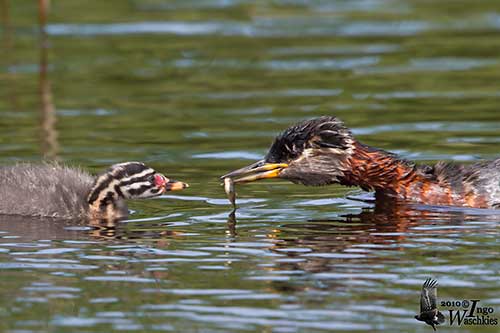
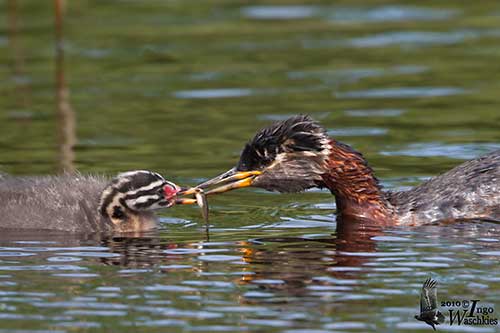
PROTECTION / THREATS / STATUS:
The Red-necked Grebe is threatened by pesticides which affect the breeding success, involving egg sterility and eggshell thinning. Degradation of lakes is due to human disturbance and recreational activities. Oil spill at sea during winter may affect the species too, although the birds occur mainly along the coasts.
Some natural predators such as Corvidae, gulls, Bald Eagle, racoons, minks and muskrats are known to feed on eggs and chicks, while the adults are preyed upon by the Great Horned Owl.
The global population is estimated to number 190,000/290,000 individuals (2006) and is decreasing. But currently, the Red-necked Grebe is evaluated as Least Concern.
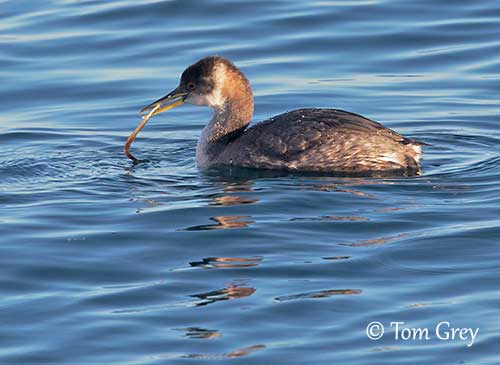
P.g. holbollii
Winter plumage